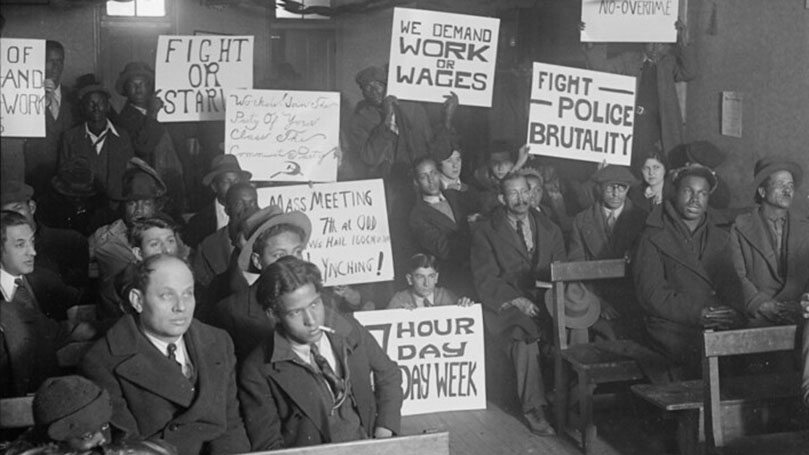
The following is an excerpt of William Z. Foster’s History of the Communist Party of the United States, ch. 20, “The Communist Party and the Great Economic Crisis (1929–1933),” published in 1952.
The National Unemployed Council, made up of workers of all political affiliations, was organized in Chicago, on July 4, 1930, at a convention of 1,320 delegates. It was fully backed by the C.P., T.U.U.L., and Y.C.L. Local unemployed councils were set up in scores of cities all over the country. Besides the unemployed, the movement also included trade unions, fraternal societies, Negro organizations, and other sympathetic groupings. The councils fought for unemployment insurance, immediate cash and work relief, public work at union wages, food for school children, against eviction, against Negro discrimination, and so on.
They used mass meetings, parades, petitions, picketing, hunger marches, and many other forms of agitation and struggle; they formed block committees to organize the workers in their homes. The main instrument for work inside the A.F. of L. was the A.F. of L. Committee for Unemployment Insurance and Relief, headed by Louis Weinstock of the Painters Union, which won the direct support of 3,000 local unions, 35 city central labor councils, 6 state federations, and 5 international unions. This movement concentrated its general political demand on the Workers Unemployment Insurance Bill (H.R. 2827).
The Unemployed Councils, in the face of widespread police brutality, conducted a mass of activities to bring pressure upon employers, local relief boards, and the city, state, and national governments. They led hundreds of demonstrations on a local and national scale. Some of the most important national mass movements were those on May 1, 1930, with 350,000 participating; on National Unemployment Insurance Day, February 25, 1931, with 400,000 demonstrators, and the turnout, on February 4, 1932, with 500,000 in the nationwide mass meetings. Three times mass petitions with a million signatures or more were presented to Congress. There were also hunger marches from the industrial centers to the capitals in many states. And then there were the two national hunger marches to Washington on December 7, 1931 (1,800 marchers) and December 6, 1932 (3,000 marchers).
These national hunger marches attracted tremendous attention. They were highly organized. The marchers traveled in old automobiles, which had been collected; the participants were registered, and each car, detachment, and column had a leader. The strictest discipline prevailed. Columns started from St. Louis, Chicago, Buffalo, Boston, and elsewhere, with regularly scheduled and organized stop-over places. All the columns converged upon Washington with clockwork precision The return journey was made in an equally disciplined and organized manner. Attempts of American Legion elements and assorted hoodlums to break up the marches en route failed.
In Washington the marchers were a sensation. Their band played The International on the great plaza before the Capitol. Thousands of police and detectives had been mobilized from all over the country. Troops at nearby forts were held in readiness. One would have thought the marchers were going to try to overthrow the government. As the first hunger march went along Pennsylvania Avenue from the Capitol to the White House (and later to the A.F. of L. building) to lay its demands before Hoover (and [AFL president William] Green) the parade was flanked on both sides by rows of marching policemen who outnumbered the hunger marchers by at least two to one. The Party concentrated its entire forces upon making these national marches successful.
The manifold activities of the Unemployed Councils, besides making a burning national issue of unemployment insurance, also resulted in securing many immediate relief concessions to the unemployed all over the country. The frightened capitalist class saw that the old game of letting the workers starve it out during economic crises would no longer work. They were dealing with an awakening working class, one which in the next few years would write some epic labor history.
Excerpted from History of the Communist Party of the United States, by William Z. Foster (New York: International Publishers, 1952).
Image: Washington Area Spark, Creative Commons (BY-NC 2.0).


 Join Now
Join Now